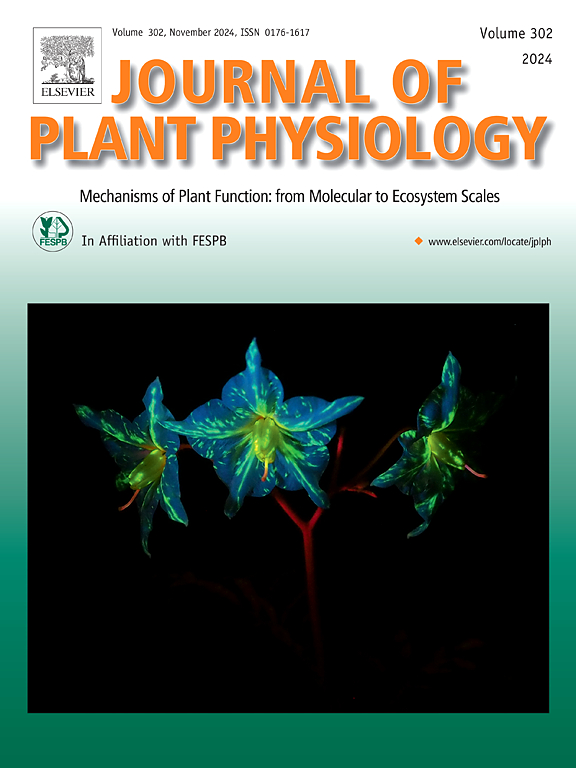地磁场减弱为低磁场对番茄(Solanum lycopersicum L. cv Microtom)植株发育过程中基因表达和代谢组学的影响
IF 4
3区 生物学
Q1 PLANT SCIENCES
引用次数: 0
摘要
将地磁场(GMF)与生命进化联系起来的一个有趣的方面在于植物如何对地磁场(也称为低磁场(HMF))的减少做出反应。本研究以番茄(Solanum lycopersicum cv Microtom)为研究对象,研究了转基因玉米和HMF对番茄叶片和果实发育的影响。采用qRT-PCR技术检测活性氧(Reactive Oxygen Species, ROS)、蛋白质、脂肪酸、多酚、叶绿素、类胡萝卜素和植物激素等初级和次级代谢物编码基因的表达变化,采用GC-MS和HPLC-MS技术检测相应代谢物水平。果蝇磁感受器MagR的两个番茄同源物Isca-like 1和erpA - 2被HMF调节,正如许多正在研究的番茄基因一样。在番茄叶片中,与植物激素产生、活性氧清除和产生以及脂质代谢相关的基因大部分呈正相关,而在花和果实中则呈几乎相反的趋势。有趣的是,Isca-like 1和erpA - 2的下调被发现与大多数未成熟水果基因的上调相关。HMF降低了叶绿素和类胡萝卜素含量,降低了光合效率,增加了非光化学猝灭。生长素、赤霉素、细胞分裂素、脱落酸、茉莉酸和水杨酸含量及其代谢相关基因的表达与番茄ISCA调控相关。结果表明,Isca-like 1和erpA - 2可能在番茄的磁感受中起重要作用。本文章由计算机程序翻译,如有差异,请以英文原文为准。
Reduction of the geomagnetic field to hypomagnetic field modulates tomato (Solanum lycopersicum L. cv Microtom) gene expression and metabolomics during plant development
An interesting aspect that links the geomagnetic field (GMF) to the evolution of life lies in how plants respond to the reduction of the GMF, also known as hypomagnetic field (HMF). In this work, tomato plants (Solanum lycopersicum cv Microtom) were exposed either to GMF or HMF and were studied during the development of leaves and fruit set. Changes of expression of genes encoding for primary and secondary metabolites, including Reactive Oxygen Species (ROS), proteins, fatty acids, polyphenols, chlorophylls, carotenoids and phytohormones were assessed by qRT-PCR, while the corresponding metabolite levels were quantified by GC-MS and HPLC-MS. Two tomato homologs of the fruit fly magnetoreceptor MagR, Isca-like 1 and erpA 2, were modulated by HMF, as were numerous tomato genes under investigation. In tomato leaves, positive correlations were observed with most of the genes associated with phytohormones production, ROS scavenging and production, and lipid metabolism, whereas an almost reversed trend was found in flowers and fruits. Interestingly, downregulation of Isca-like 1 and erpA 2 was found to correlate with an upregulation of most unripe fruit genes. Exposure to HMF reduced chlorophyll and carotenoid content, decreased photosynthetic efficiency and increased non-photochemical quenching. Auxins, gibberellins, cytokinins, abscisic acid, jasmonic acid and salicylic acid content and the expression of genes related to their metabolism correlated with tomato ISCA modulation. The results here reported suggest that Isca-like 1 and erpA 2 might be important players in tomato magnetoreception.
求助全文
通过发布文献求助,成功后即可免费获取论文全文。
去求助
来源期刊

Journal of plant physiology
生物-植物科学
CiteScore
7.20
自引率
4.70%
发文量
196
审稿时长
32 days
期刊介绍:
The Journal of Plant Physiology is a broad-spectrum journal that welcomes high-quality submissions in all major areas of plant physiology, including plant biochemistry, functional biotechnology, computational and synthetic plant biology, growth and development, photosynthesis and respiration, transport and translocation, plant-microbe interactions, biotic and abiotic stress. Studies are welcome at all levels of integration ranging from molecules and cells to organisms and their environments and are expected to use state-of-the-art methodologies. Pure gene expression studies are not within the focus of our journal. To be considered for publication, papers must significantly contribute to the mechanistic understanding of physiological processes, and not be merely descriptive, or confirmatory of previous results. We encourage the submission of papers that explore the physiology of non-model as well as accepted model species and those that bridge basic and applied research. For instance, studies on agricultural plants that show new physiological mechanisms to improve agricultural efficiency are welcome. Studies performed under uncontrolled situations (e.g. field conditions) not providing mechanistic insight will not be considered for publication.
The Journal of Plant Physiology publishes several types of articles: Original Research Articles, Reviews, Perspectives Articles, and Short Communications. Reviews and Perspectives will be solicited by the Editors; unsolicited reviews are also welcome but only from authors with a strong track record in the field of the review. Original research papers comprise the majority of published contributions.
 求助内容:
求助内容: 应助结果提醒方式:
应助结果提醒方式:


